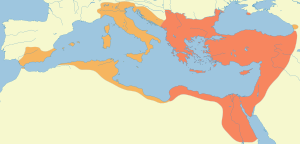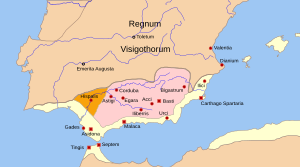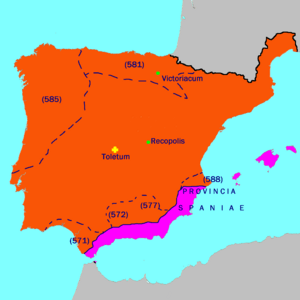Spania facts for kids
Quick facts for kids Province of Spania
Provincia Spaniæ
|
|||||||||
|---|---|---|---|---|---|---|---|---|---|
| Province of the Byzantine (Roman) Empire | |||||||||
| 552–624 | |||||||||
 Spania at its greatest extent, around the time of its foundation |
|||||||||
| Capital | Malaca (Málaga) or Carthago Spartaria (Cartagena) | ||||||||
| Historical era | Late Antiquity | ||||||||
|
• Byzantine reconquest by Liberius
|
552 | ||||||||
|
• Visigothic reconquest
|
624 | ||||||||
|
|||||||||
| Today part of | United Kingdom · Gibraltar Portugal Spain |
||||||||
Spania (Latin: Provincia Spaniae) was a special area, like a province, that belonged to the Eastern Roman Empire (also called the Byzantine Empire). It existed from 552 to 624 AD. This province was located in the southern part of the Iberian Peninsula (modern-day Spain and Portugal) and included the Balearic Islands. The Byzantine Emperor Justinian I created Spania. He hoped to get back the western parts of the old Roman Empire.
Contents
Why Was Spania Created?
The Visigoths Take Over Spain
Around 409 AD, groups like the Vandals, Suevi, and Alans crossed into the Iberian Peninsula. They had already broken through Roman defenses in other areas. Even so, the Romans kept control of most of Spain until about 461 AD.
The Visigoths were a Germanic people who had settled in France. They were allies of the Roman Empire. As Roman power faded, the Visigoths became more important in Spain. In 468, they defeated the Suevi. By 473, the Visigoths had ended Roman rule in Spain. They controlled most of the eastern and central parts of the peninsula. After losing land in France to the Franks in 507, the Visigoths moved their main power to Spain.
Byzantine Empire Steps In
In 534, the Roman general Belisarius took back North Africa from the Vandals for the Byzantine Empire. This area was called Mauretania. The Visigothic king, Theudis, took Ceuta (a city across from Gibraltar) in 533. He probably wanted to keep it from the Byzantines. But the Byzantines quickly captured Ceuta the next year. Ceuta became an important base for them to watch Spain.
In 550, the Visigothic king Agila I faced many rebellions in Spain. The people of Córdoba rebelled against his rule. Agila was badly defeated, and his son was killed. Another nobleman, Athanagild, took Seville and claimed to be king.
Athanagild asked Emperor Justinian I for help. In 552, a Byzantine army landed in Spain, probably near Málaga. They joined Athanagild and defeated Agila. The war continued for two more years. In 555, Agila's supporters killed him, making Athanagild the new king.
Athanagild then tried to get rid of the Byzantines, but he failed. The Byzantines kept control of many coastal cities in southern Spain. This area became the new Byzantine province of Spania.
Where Was Spania Located?
The Byzantine province of Spania never reached very far inland. The Byzantines likely saw it as a defense against a Visigothic attack on North Africa. This was important because the Persian Empire was a bigger threat in the East.
The most important cities in Byzantine Spania were Málaga and Cartagena. These were likely where the Byzantine army first landed. It's not clear which city was the capital, but it was probably one of them. These cities were strongholds of Byzantine power. Even though the Visigoths often attacked the countryside, they were not good at sieges. So, the fortified towns remained safe centers of Roman rule.
Few cities are known for sure to have been under Byzantine control. Medina Sidonia was held until 572. Gisgonza was held until around 603-610. This shows that the southern part of the province of Baetica was completely Byzantine, from Málaga to the mouth of the Guadalete river. In the province of Carthaginiensis, where Cartagena was located, the city of Baza was also Byzantine.
Some historians think Córdoba might have been the first capital of Spania. But there is no clear proof that the Romans ruled Córdoba or other nearby cities like Ecija or Granada. Córdoba was in rebellion for a while until the Visigoths took it in 572.
Besides southern Spain, the Byzantines also held Ceuta (across from Gibraltar) and the Balearic Islands. The Balearic Islands had become Byzantine when they took over the Vandal kingdom. By 600 AD, Spania had shrunk to mainly Málaga, Cartagena, and the Balearic Islands. It did not extend north of the Sierra Nevada mountains.
How Was Spania Governed?
Government Leaders
The main leader in Spania was called the magister militum Spaniae. This means "master of the military of Spain." This person managed both civil (everyday life) and military matters. They answered only to the Emperor. The magister was usually a very important noble, often with the title of patrician. This position was likely created by Emperor Justinian. The province even had its own mint, making its own money until it fell around 625 AD.
We know of five magistri who governed Spania. One, named Comenciolus, repaired the gates of Cartagena in 589. He left an inscription in Latin, showing that Latin was still used for official business. Another governor, Caesarius, made a peace treaty with the Visigothic king Sisebut in 614.
Travel and trade between Spania and the Visigothic kingdom were allowed. The border was set by a treaty between Athanagild and Justinian I. This treaty was respected for a long time, which made travel easy.
Church Leaders
Most people in Spania were Latin Christians. The Byzantine governors were also Christians, though some were Eastern Christians. The church in Spania was more connected to the Papacy (the Pope) than the Visigothic church was. The two churches were separate, and their leaders did not attend each other's meetings.
Pope Gregory the Great often got involved in the church matters of Spania. He helped bishops who had been removed from their positions. He also criticized the magister militum Comitiolus for interfering with church affairs.
Daily Life and Culture
The art and building styles in Spania were not exactly like those in Byzantium (the capital, Constantinople). Instead, they were more like the Byzantine styles found in North Africa. For example, two churches excavated in Spain show this African influence. Only in the Balearic Islands did the styles from Greece and Thrace take hold.
Pottery found near Cartagena also shows strong links to North Africa. This includes special African amphorae (jars). Recent excavations in Cartagena have found a housing complex, possibly for Byzantine soldiers. Many items from the Byzantine presence can be seen in the Museo Arqueológico de Cartagena. However, like most cities in Spain at that time, Cartagena's population and size decreased under Byzantine rule.
Decline and End of Spania
Over time, the Byzantines struggled to expand their control. The Visigoths, under kings like Athanagild and Leovigild, began to take back land. Around 570, Leovigild attacked the region of Baza and captured Medina Sidonia. He also raided areas around Málaga. He took many cities and forts in the Guadalquivir river valley.
During the rule of King Reccared, the Byzantines tried to gain back territory. Reccared accepted the Byzantine border. However, the Byzantine province of Spania was clearly shrinking.
Later kings, like Witteric and Gundemar, also fought against Spania. But King Sisebut was especially successful. In 614 and 615, he led big military campaigns against the Byzantines. He captured Málaga before 619. He destroyed many cities along the coast. The Frankish historian Fredegar wrote that Sisebut "took many cities from the Roman empire along the coast, destroying them and reducing them to rubble."
Sisebut likely destroyed Cartagena so completely that it never recovered in Visigothic Spain. The Visigoths were not good at sieges, so they often destroyed the defenses of any fortified places they captured. This prevented future enemies from using them.
By 621, the Byzantines held only a few towns. King Suinthila quickly took these back. By 624, the entire province of Spania was in Visigothic hands. Only the Balearic Islands remained, but they were not very important economically. They were later separated from the Byzantine Empire by Arab attacks in the 8th to 10th centuries.
Later, a Byzantine fleet raided the coasts of southern Spain. This happened during the rule of Visigothic kings Egica and Wittiza. A local count named Theudimer drove them off. This was likely an isolated event, probably connected to other military actions against the Arabs, not an attempt to get Spania back.
|
See also
 In Spanish: Provincia de Spania para niños
In Spanish: Provincia de Spania para niños






